MSc Management Strategy: Comprehensive Starbucks Business Report
VerifiedAdded on 2022/09/01
|18
|5101
|21
Report
AI Summary
This report provides a comprehensive analysis of Starbucks' business strategy, encompassing both external and internal environmental factors. The external environment is assessed using PESTLE and Porter's Five Forces analyses, while the industry lifecycle model is also considered. The internal environment is evaluated through VRIO and value chain analyses, along with a resources, capabilities, and competencies framework. The report also includes a stakeholder analysis and concludes with recommendations. The study examines Starbucks' growth, market position, competitive landscape, and strategic decisions, offering insights into its successes and challenges. The report aims to understand Starbucks' strategic positioning within the global coffee market and provides recommendations for future strategies.
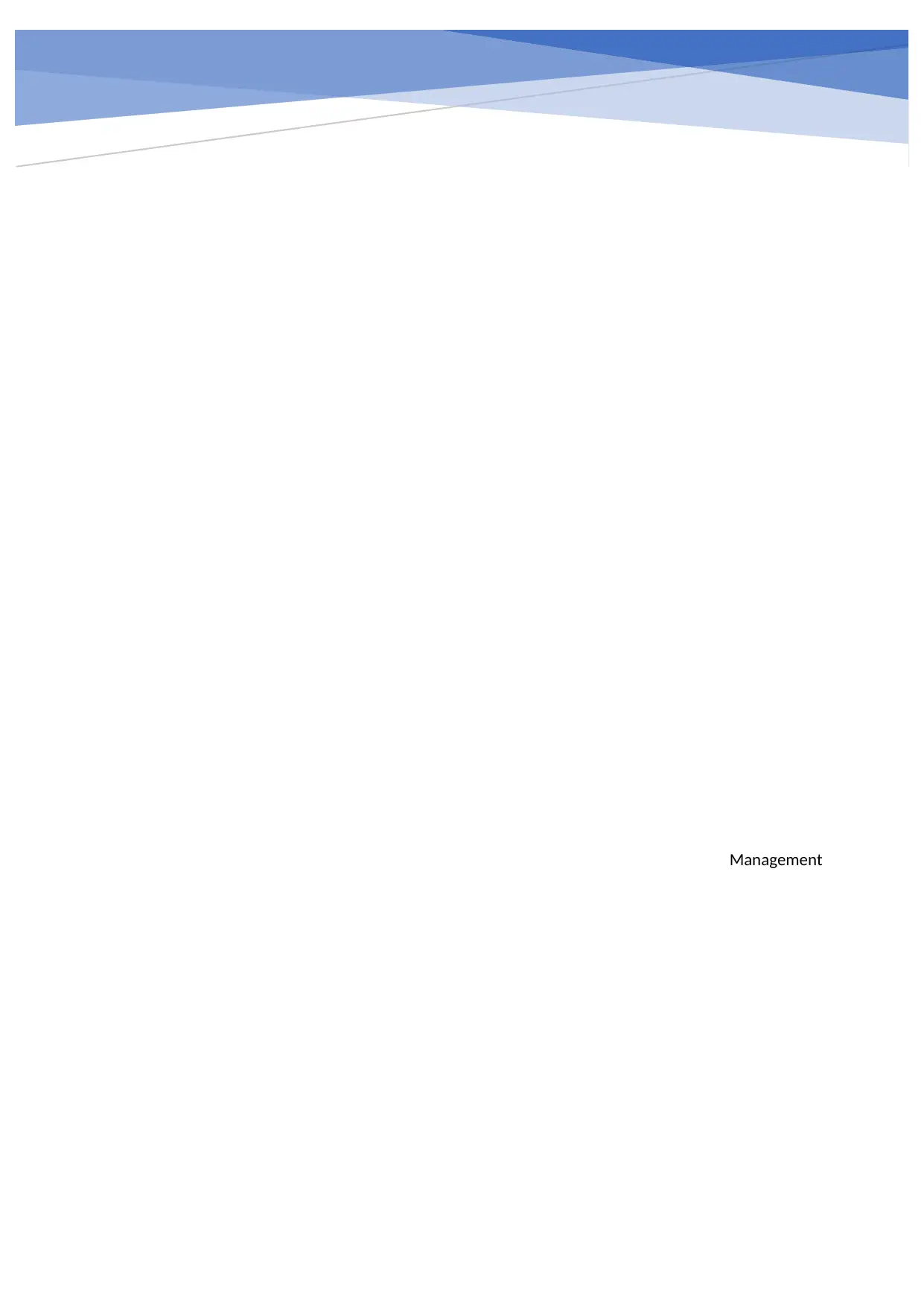
Management
Paraphrase This Document
Need a fresh take? Get an instant paraphrase of this document with our AI Paraphraser
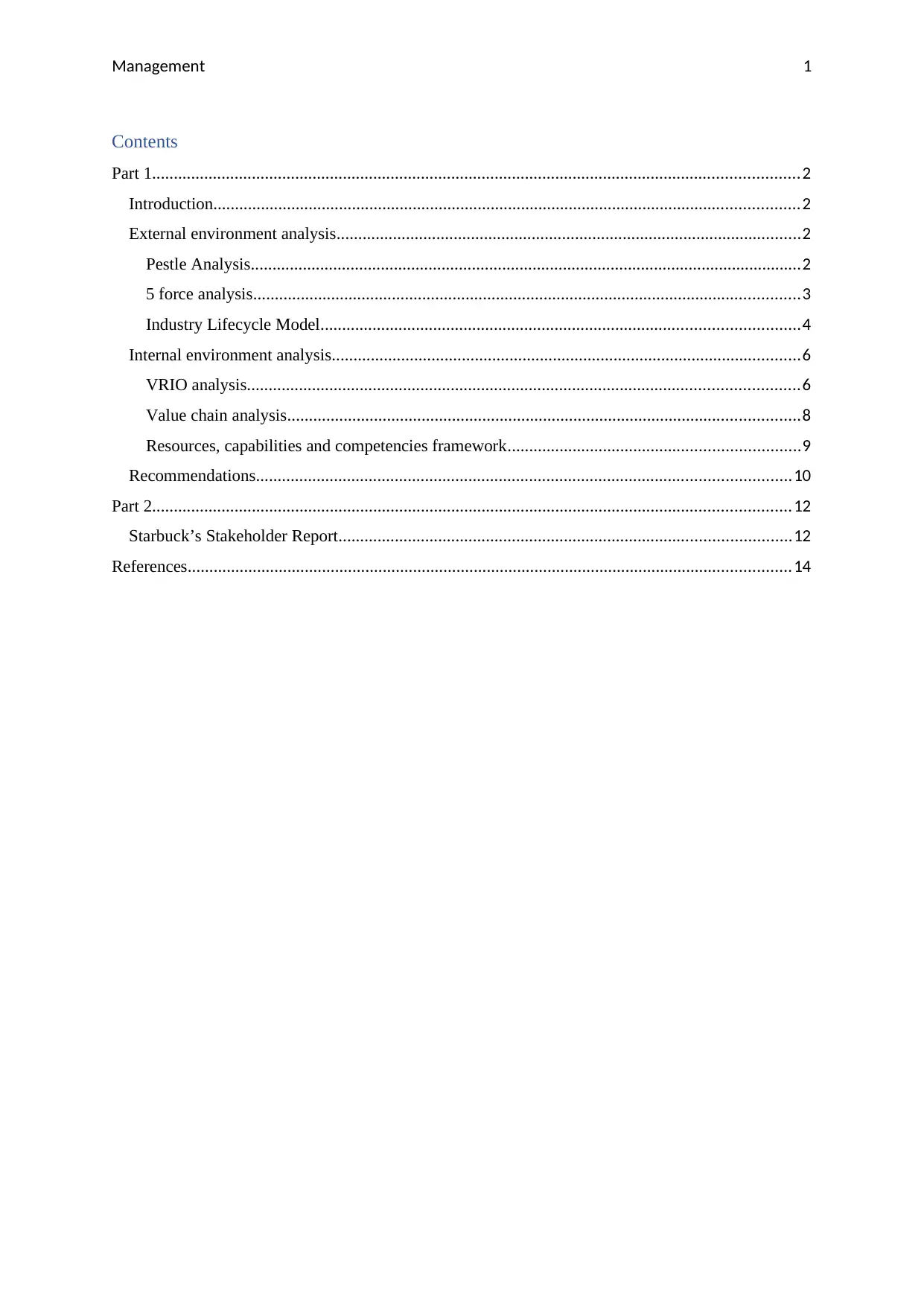
Management 1
Contents
Part 1.....................................................................................................................................................2
Introduction.......................................................................................................................................2
External environment analysis...........................................................................................................2
Pestle Analysis...............................................................................................................................2
5 force analysis..............................................................................................................................3
Industry Lifecycle Model..............................................................................................................4
Internal environment analysis............................................................................................................6
VRIO analysis...............................................................................................................................6
Value chain analysis......................................................................................................................8
Resources, capabilities and competencies framework...................................................................9
Recommendations...........................................................................................................................10
Part 2...................................................................................................................................................12
Starbuck’s Stakeholder Report........................................................................................................12
References...........................................................................................................................................14
Contents
Part 1.....................................................................................................................................................2
Introduction.......................................................................................................................................2
External environment analysis...........................................................................................................2
Pestle Analysis...............................................................................................................................2
5 force analysis..............................................................................................................................3
Industry Lifecycle Model..............................................................................................................4
Internal environment analysis............................................................................................................6
VRIO analysis...............................................................................................................................6
Value chain analysis......................................................................................................................8
Resources, capabilities and competencies framework...................................................................9
Recommendations...........................................................................................................................10
Part 2...................................................................................................................................................12
Starbuck’s Stakeholder Report........................................................................................................12
References...........................................................................................................................................14
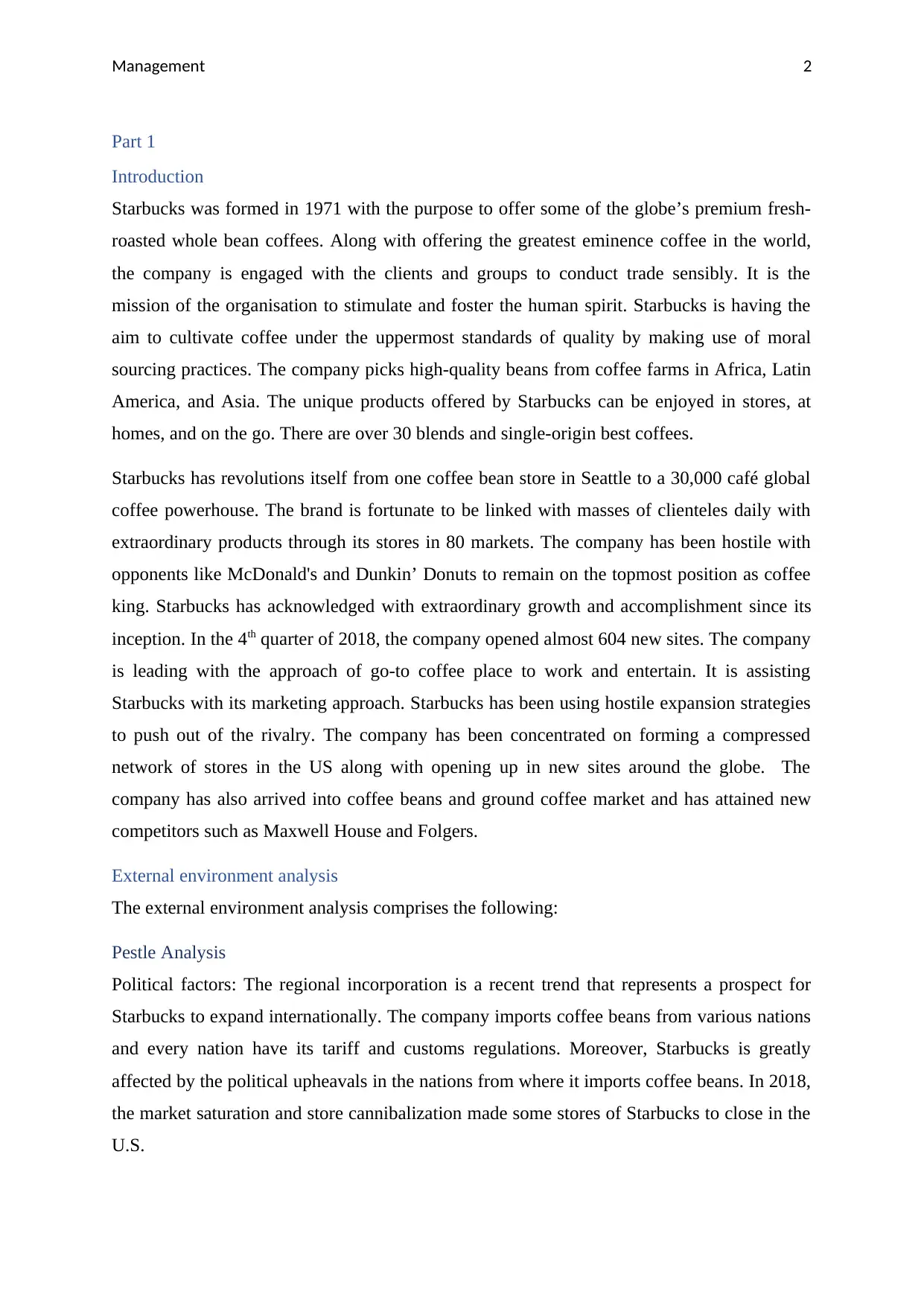
Management 2
Part 1
Introduction
Starbucks was formed in 1971 with the purpose to offer some of the globe’s premium fresh-
roasted whole bean coffees. Along with offering the greatest eminence coffee in the world,
the company is engaged with the clients and groups to conduct trade sensibly. It is the
mission of the organisation to stimulate and foster the human spirit. Starbucks is having the
aim to cultivate coffee under the uppermost standards of quality by making use of moral
sourcing practices. The company picks high-quality beans from coffee farms in Africa, Latin
America, and Asia. The unique products offered by Starbucks can be enjoyed in stores, at
homes, and on the go. There are over 30 blends and single-origin best coffees.
Starbucks has revolutions itself from one coffee bean store in Seattle to a 30,000 café global
coffee powerhouse. The brand is fortunate to be linked with masses of clienteles daily with
extraordinary products through its stores in 80 markets. The company has been hostile with
opponents like McDonald's and Dunkin’ Donuts to remain on the topmost position as coffee
king. Starbucks has acknowledged with extraordinary growth and accomplishment since its
inception. In the 4th quarter of 2018, the company opened almost 604 new sites. The company
is leading with the approach of go-to coffee place to work and entertain. It is assisting
Starbucks with its marketing approach. Starbucks has been using hostile expansion strategies
to push out of the rivalry. The company has been concentrated on forming a compressed
network of stores in the US along with opening up in new sites around the globe. The
company has also arrived into coffee beans and ground coffee market and has attained new
competitors such as Maxwell House and Folgers.
External environment analysis
The external environment analysis comprises the following:
Pestle Analysis
Political factors: The regional incorporation is a recent trend that represents a prospect for
Starbucks to expand internationally. The company imports coffee beans from various nations
and every nation have its tariff and customs regulations. Moreover, Starbucks is greatly
affected by the political upheavals in the nations from where it imports coffee beans. In 2018,
the market saturation and store cannibalization made some stores of Starbucks to close in the
U.S.
Part 1
Introduction
Starbucks was formed in 1971 with the purpose to offer some of the globe’s premium fresh-
roasted whole bean coffees. Along with offering the greatest eminence coffee in the world,
the company is engaged with the clients and groups to conduct trade sensibly. It is the
mission of the organisation to stimulate and foster the human spirit. Starbucks is having the
aim to cultivate coffee under the uppermost standards of quality by making use of moral
sourcing practices. The company picks high-quality beans from coffee farms in Africa, Latin
America, and Asia. The unique products offered by Starbucks can be enjoyed in stores, at
homes, and on the go. There are over 30 blends and single-origin best coffees.
Starbucks has revolutions itself from one coffee bean store in Seattle to a 30,000 café global
coffee powerhouse. The brand is fortunate to be linked with masses of clienteles daily with
extraordinary products through its stores in 80 markets. The company has been hostile with
opponents like McDonald's and Dunkin’ Donuts to remain on the topmost position as coffee
king. Starbucks has acknowledged with extraordinary growth and accomplishment since its
inception. In the 4th quarter of 2018, the company opened almost 604 new sites. The company
is leading with the approach of go-to coffee place to work and entertain. It is assisting
Starbucks with its marketing approach. Starbucks has been using hostile expansion strategies
to push out of the rivalry. The company has been concentrated on forming a compressed
network of stores in the US along with opening up in new sites around the globe. The
company has also arrived into coffee beans and ground coffee market and has attained new
competitors such as Maxwell House and Folgers.
External environment analysis
The external environment analysis comprises the following:
Pestle Analysis
Political factors: The regional incorporation is a recent trend that represents a prospect for
Starbucks to expand internationally. The company imports coffee beans from various nations
and every nation have its tariff and customs regulations. Moreover, Starbucks is greatly
affected by the political upheavals in the nations from where it imports coffee beans. In 2018,
the market saturation and store cannibalization made some stores of Starbucks to close in the
U.S.
⊘ This is a preview!⊘
Do you want full access?
Subscribe today to unlock all pages.

Trusted by 1+ million students worldwide
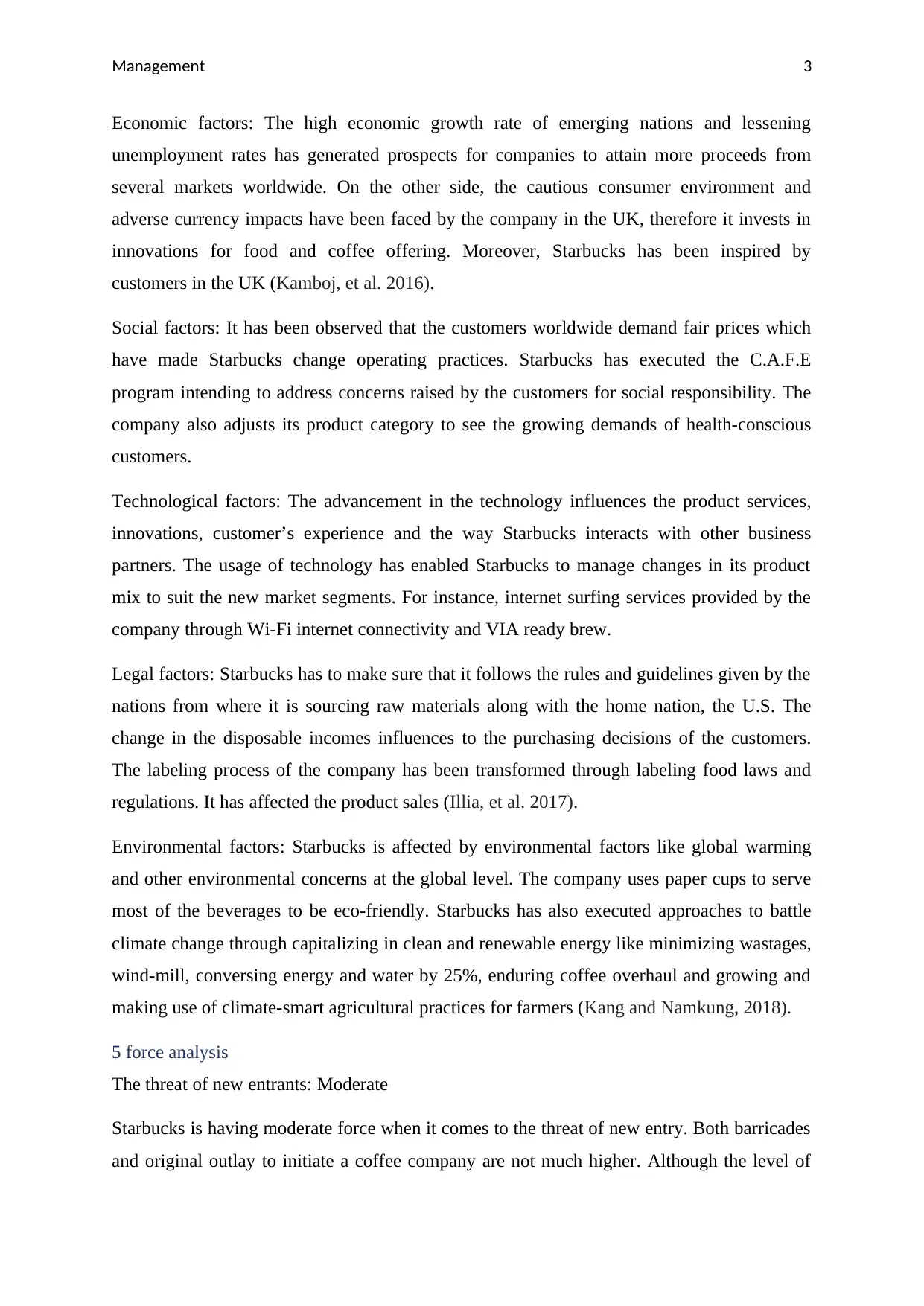
Management 3
Economic factors: The high economic growth rate of emerging nations and lessening
unemployment rates has generated prospects for companies to attain more proceeds from
several markets worldwide. On the other side, the cautious consumer environment and
adverse currency impacts have been faced by the company in the UK, therefore it invests in
innovations for food and coffee offering. Moreover, Starbucks has been inspired by
customers in the UK (Kamboj, et al. 2016).
Social factors: It has been observed that the customers worldwide demand fair prices which
have made Starbucks change operating practices. Starbucks has executed the C.A.F.E
program intending to address concerns raised by the customers for social responsibility. The
company also adjusts its product category to see the growing demands of health-conscious
customers.
Technological factors: The advancement in the technology influences the product services,
innovations, customer’s experience and the way Starbucks interacts with other business
partners. The usage of technology has enabled Starbucks to manage changes in its product
mix to suit the new market segments. For instance, internet surfing services provided by the
company through Wi-Fi internet connectivity and VIA ready brew.
Legal factors: Starbucks has to make sure that it follows the rules and guidelines given by the
nations from where it is sourcing raw materials along with the home nation, the U.S. The
change in the disposable incomes influences to the purchasing decisions of the customers.
The labeling process of the company has been transformed through labeling food laws and
regulations. It has affected the product sales (Illia, et al. 2017).
Environmental factors: Starbucks is affected by environmental factors like global warming
and other environmental concerns at the global level. The company uses paper cups to serve
most of the beverages to be eco-friendly. Starbucks has also executed approaches to battle
climate change through capitalizing in clean and renewable energy like minimizing wastages,
wind-mill, conversing energy and water by 25%, enduring coffee overhaul and growing and
making use of climate-smart agricultural practices for farmers (Kang and Namkung, 2018).
5 force analysis
The threat of new entrants: Moderate
Starbucks is having moderate force when it comes to the threat of new entry. Both barricades
and original outlay to initiate a coffee company are not much higher. Although the level of
Economic factors: The high economic growth rate of emerging nations and lessening
unemployment rates has generated prospects for companies to attain more proceeds from
several markets worldwide. On the other side, the cautious consumer environment and
adverse currency impacts have been faced by the company in the UK, therefore it invests in
innovations for food and coffee offering. Moreover, Starbucks has been inspired by
customers in the UK (Kamboj, et al. 2016).
Social factors: It has been observed that the customers worldwide demand fair prices which
have made Starbucks change operating practices. Starbucks has executed the C.A.F.E
program intending to address concerns raised by the customers for social responsibility. The
company also adjusts its product category to see the growing demands of health-conscious
customers.
Technological factors: The advancement in the technology influences the product services,
innovations, customer’s experience and the way Starbucks interacts with other business
partners. The usage of technology has enabled Starbucks to manage changes in its product
mix to suit the new market segments. For instance, internet surfing services provided by the
company through Wi-Fi internet connectivity and VIA ready brew.
Legal factors: Starbucks has to make sure that it follows the rules and guidelines given by the
nations from where it is sourcing raw materials along with the home nation, the U.S. The
change in the disposable incomes influences to the purchasing decisions of the customers.
The labeling process of the company has been transformed through labeling food laws and
regulations. It has affected the product sales (Illia, et al. 2017).
Environmental factors: Starbucks is affected by environmental factors like global warming
and other environmental concerns at the global level. The company uses paper cups to serve
most of the beverages to be eco-friendly. Starbucks has also executed approaches to battle
climate change through capitalizing in clean and renewable energy like minimizing wastages,
wind-mill, conversing energy and water by 25%, enduring coffee overhaul and growing and
making use of climate-smart agricultural practices for farmers (Kang and Namkung, 2018).
5 force analysis
The threat of new entrants: Moderate
Starbucks is having moderate force when it comes to the threat of new entry. Both barricades
and original outlay to initiate a coffee company are not much higher. Although the level of
Paraphrase This Document
Need a fresh take? Get an instant paraphrase of this document with our AI Paraphraser
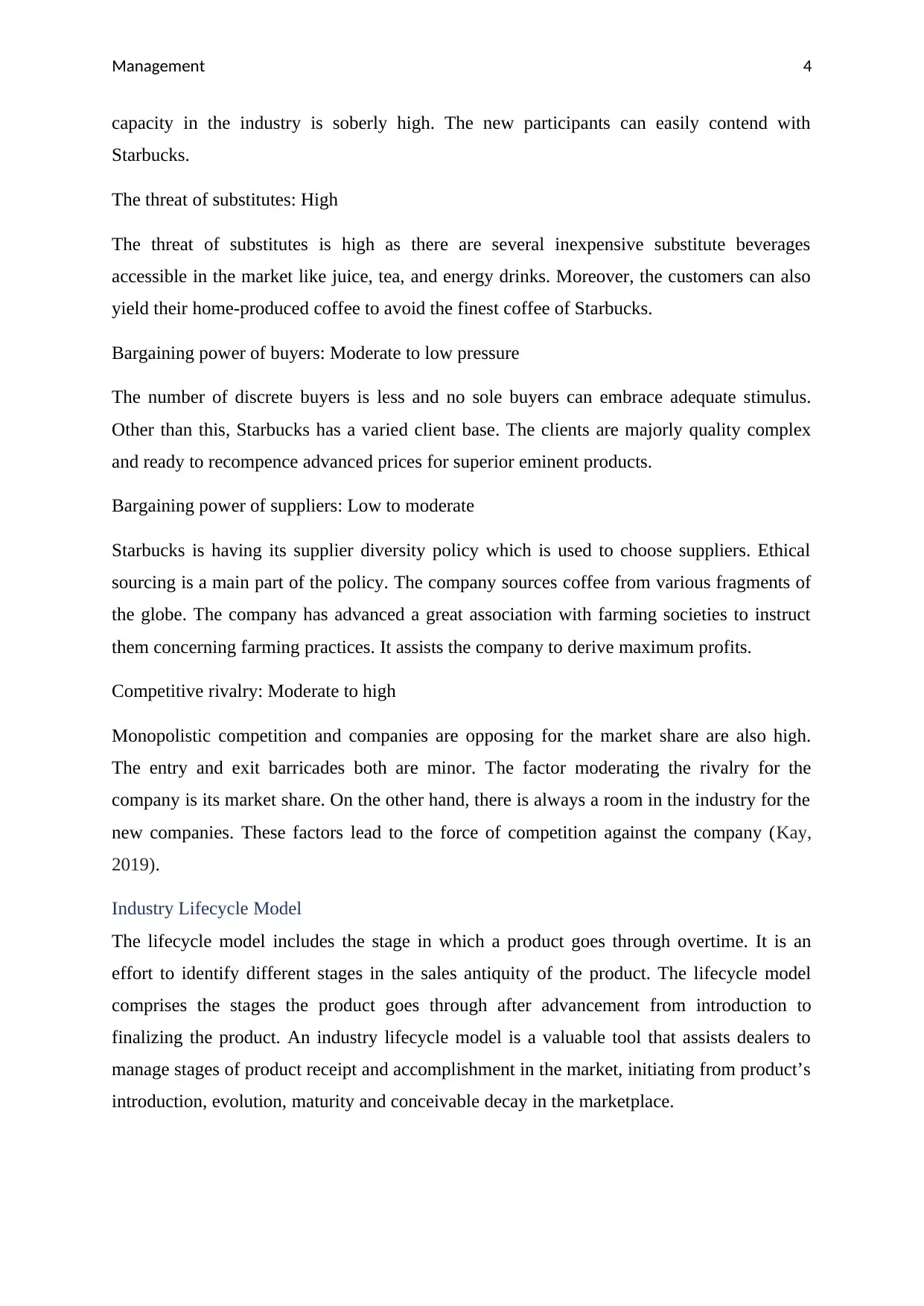
Management 4
capacity in the industry is soberly high. The new participants can easily contend with
Starbucks.
The threat of substitutes: High
The threat of substitutes is high as there are several inexpensive substitute beverages
accessible in the market like juice, tea, and energy drinks. Moreover, the customers can also
yield their home-produced coffee to avoid the finest coffee of Starbucks.
Bargaining power of buyers: Moderate to low pressure
The number of discrete buyers is less and no sole buyers can embrace adequate stimulus.
Other than this, Starbucks has a varied client base. The clients are majorly quality complex
and ready to recompence advanced prices for superior eminent products.
Bargaining power of suppliers: Low to moderate
Starbucks is having its supplier diversity policy which is used to choose suppliers. Ethical
sourcing is a main part of the policy. The company sources coffee from various fragments of
the globe. The company has advanced a great association with farming societies to instruct
them concerning farming practices. It assists the company to derive maximum profits.
Competitive rivalry: Moderate to high
Monopolistic competition and companies are opposing for the market share are also high.
The entry and exit barricades both are minor. The factor moderating the rivalry for the
company is its market share. On the other hand, there is always a room in the industry for the
new companies. These factors lead to the force of competition against the company (Kay,
2019).
Industry Lifecycle Model
The lifecycle model includes the stage in which a product goes through overtime. It is an
effort to identify different stages in the sales antiquity of the product. The lifecycle model
comprises the stages the product goes through after advancement from introduction to
finalizing the product. An industry lifecycle model is a valuable tool that assists dealers to
manage stages of product receipt and accomplishment in the market, initiating from product’s
introduction, evolution, maturity and conceivable decay in the marketplace.
capacity in the industry is soberly high. The new participants can easily contend with
Starbucks.
The threat of substitutes: High
The threat of substitutes is high as there are several inexpensive substitute beverages
accessible in the market like juice, tea, and energy drinks. Moreover, the customers can also
yield their home-produced coffee to avoid the finest coffee of Starbucks.
Bargaining power of buyers: Moderate to low pressure
The number of discrete buyers is less and no sole buyers can embrace adequate stimulus.
Other than this, Starbucks has a varied client base. The clients are majorly quality complex
and ready to recompence advanced prices for superior eminent products.
Bargaining power of suppliers: Low to moderate
Starbucks is having its supplier diversity policy which is used to choose suppliers. Ethical
sourcing is a main part of the policy. The company sources coffee from various fragments of
the globe. The company has advanced a great association with farming societies to instruct
them concerning farming practices. It assists the company to derive maximum profits.
Competitive rivalry: Moderate to high
Monopolistic competition and companies are opposing for the market share are also high.
The entry and exit barricades both are minor. The factor moderating the rivalry for the
company is its market share. On the other hand, there is always a room in the industry for the
new companies. These factors lead to the force of competition against the company (Kay,
2019).
Industry Lifecycle Model
The lifecycle model includes the stage in which a product goes through overtime. It is an
effort to identify different stages in the sales antiquity of the product. The lifecycle model
comprises the stages the product goes through after advancement from introduction to
finalizing the product. An industry lifecycle model is a valuable tool that assists dealers to
manage stages of product receipt and accomplishment in the market, initiating from product’s
introduction, evolution, maturity and conceivable decay in the marketplace.
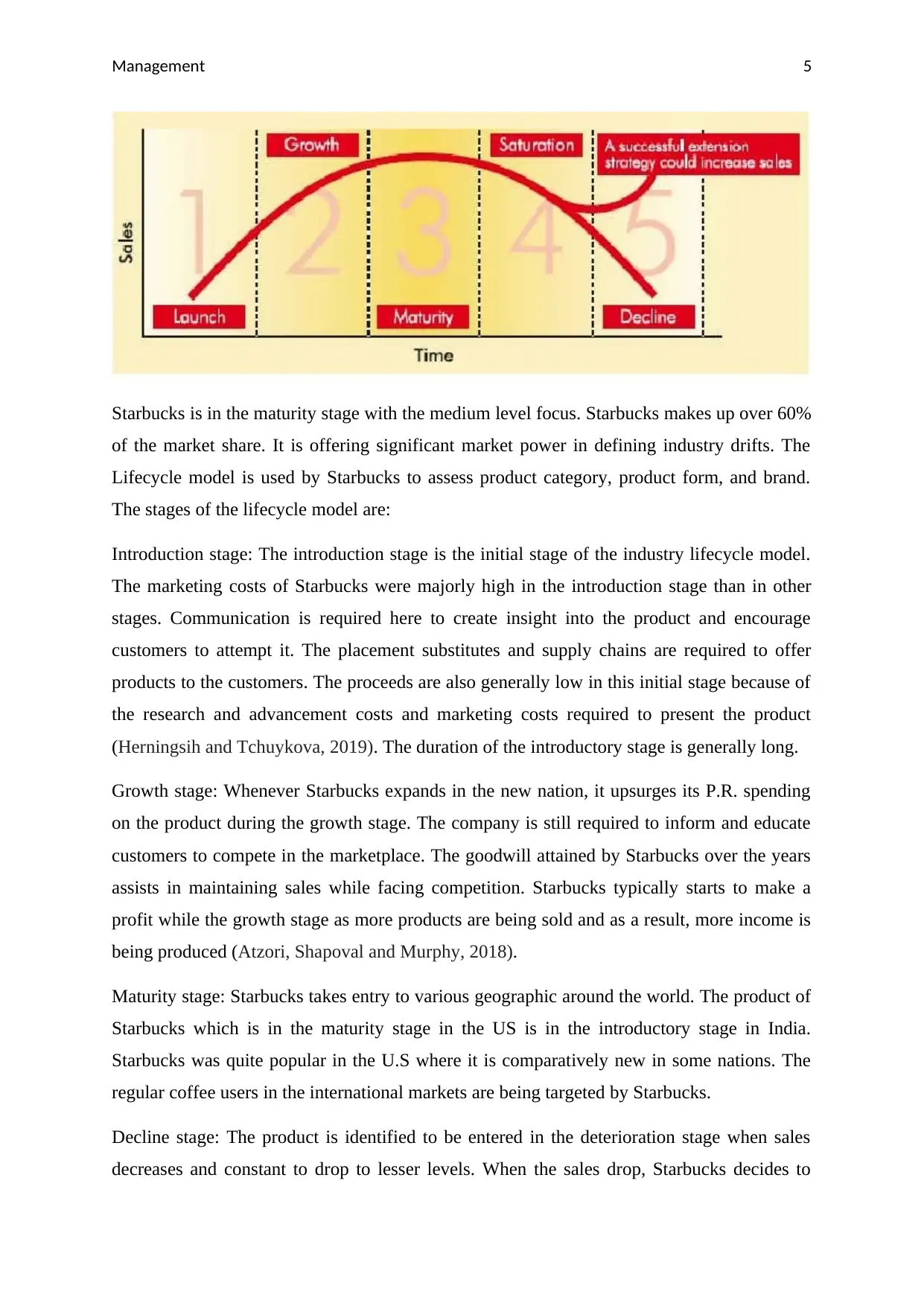
Management 5
Starbucks is in the maturity stage with the medium level focus. Starbucks makes up over 60%
of the market share. It is offering significant market power in defining industry drifts. The
Lifecycle model is used by Starbucks to assess product category, product form, and brand.
The stages of the lifecycle model are:
Introduction stage: The introduction stage is the initial stage of the industry lifecycle model.
The marketing costs of Starbucks were majorly high in the introduction stage than in other
stages. Communication is required here to create insight into the product and encourage
customers to attempt it. The placement substitutes and supply chains are required to offer
products to the customers. The proceeds are also generally low in this initial stage because of
the research and advancement costs and marketing costs required to present the product
(Herningsih and Tchuykova, 2019). The duration of the introductory stage is generally long.
Growth stage: Whenever Starbucks expands in the new nation, it upsurges its P.R. spending
on the product during the growth stage. The company is still required to inform and educate
customers to compete in the marketplace. The goodwill attained by Starbucks over the years
assists in maintaining sales while facing competition. Starbucks typically starts to make a
profit while the growth stage as more products are being sold and as a result, more income is
being produced (Atzori, Shapoval and Murphy, 2018).
Maturity stage: Starbucks takes entry to various geographic around the world. The product of
Starbucks which is in the maturity stage in the US is in the introductory stage in India.
Starbucks was quite popular in the U.S where it is comparatively new in some nations. The
regular coffee users in the international markets are being targeted by Starbucks.
Decline stage: The product is identified to be entered in the deterioration stage when sales
decreases and constant to drop to lesser levels. When the sales drop, Starbucks decides to
Starbucks is in the maturity stage with the medium level focus. Starbucks makes up over 60%
of the market share. It is offering significant market power in defining industry drifts. The
Lifecycle model is used by Starbucks to assess product category, product form, and brand.
The stages of the lifecycle model are:
Introduction stage: The introduction stage is the initial stage of the industry lifecycle model.
The marketing costs of Starbucks were majorly high in the introduction stage than in other
stages. Communication is required here to create insight into the product and encourage
customers to attempt it. The placement substitutes and supply chains are required to offer
products to the customers. The proceeds are also generally low in this initial stage because of
the research and advancement costs and marketing costs required to present the product
(Herningsih and Tchuykova, 2019). The duration of the introductory stage is generally long.
Growth stage: Whenever Starbucks expands in the new nation, it upsurges its P.R. spending
on the product during the growth stage. The company is still required to inform and educate
customers to compete in the marketplace. The goodwill attained by Starbucks over the years
assists in maintaining sales while facing competition. Starbucks typically starts to make a
profit while the growth stage as more products are being sold and as a result, more income is
being produced (Atzori, Shapoval and Murphy, 2018).
Maturity stage: Starbucks takes entry to various geographic around the world. The product of
Starbucks which is in the maturity stage in the US is in the introductory stage in India.
Starbucks was quite popular in the U.S where it is comparatively new in some nations. The
regular coffee users in the international markets are being targeted by Starbucks.
Decline stage: The product is identified to be entered in the deterioration stage when sales
decreases and constant to drop to lesser levels. When the sales drop, Starbucks decides to
⊘ This is a preview!⊘
Do you want full access?
Subscribe today to unlock all pages.

Trusted by 1+ million students worldwide
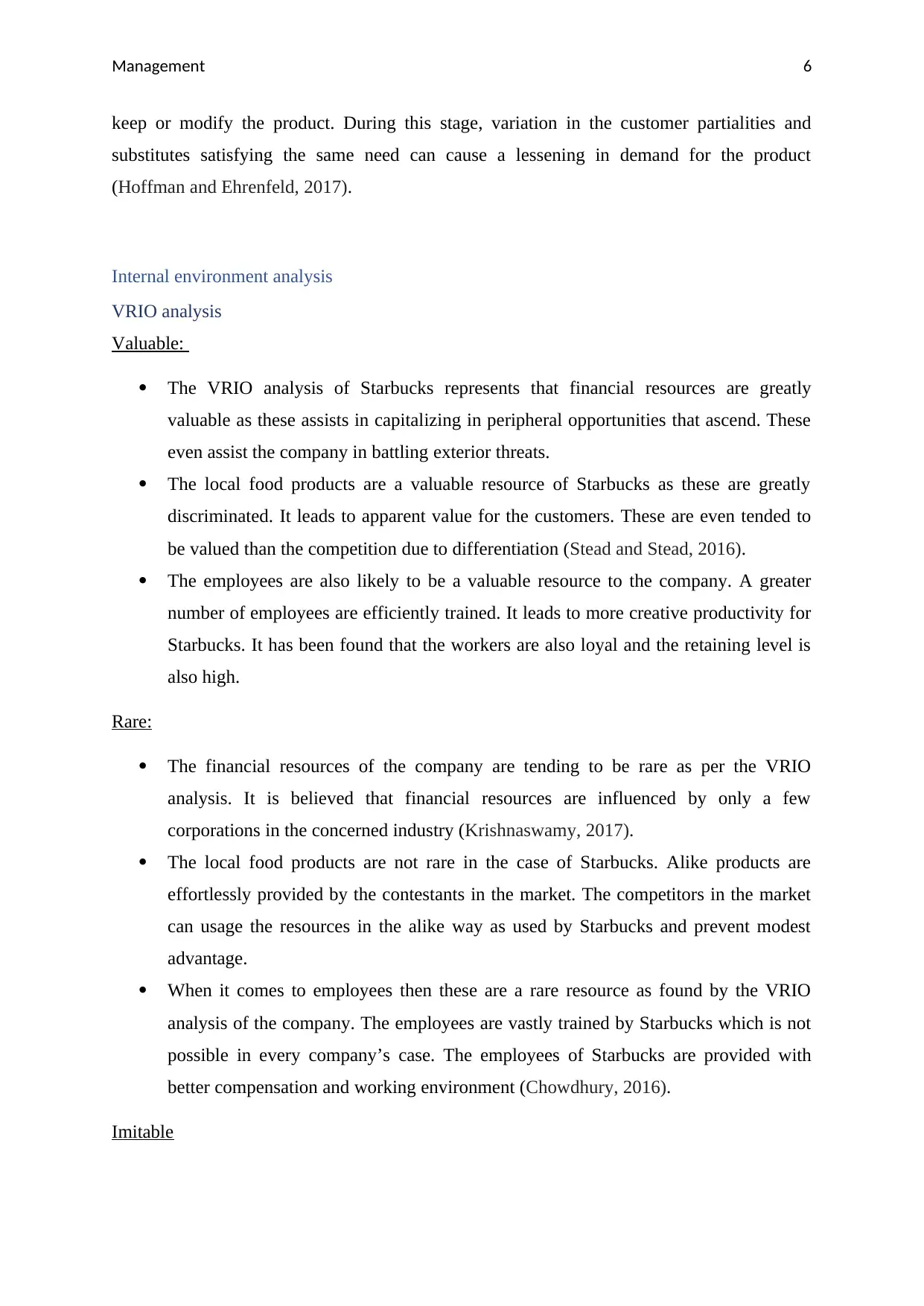
Management 6
keep or modify the product. During this stage, variation in the customer partialities and
substitutes satisfying the same need can cause a lessening in demand for the product
(Hoffman and Ehrenfeld, 2017).
Internal environment analysis
VRIO analysis
Valuable:
The VRIO analysis of Starbucks represents that financial resources are greatly
valuable as these assists in capitalizing in peripheral opportunities that ascend. These
even assist the company in battling exterior threats.
The local food products are a valuable resource of Starbucks as these are greatly
discriminated. It leads to apparent value for the customers. These are even tended to
be valued than the competition due to differentiation (Stead and Stead, 2016).
The employees are also likely to be a valuable resource to the company. A greater
number of employees are efficiently trained. It leads to more creative productivity for
Starbucks. It has been found that the workers are also loyal and the retaining level is
also high.
Rare:
The financial resources of the company are tending to be rare as per the VRIO
analysis. It is believed that financial resources are influenced by only a few
corporations in the concerned industry (Krishnaswamy, 2017).
The local food products are not rare in the case of Starbucks. Alike products are
effortlessly provided by the contestants in the market. The competitors in the market
can usage the resources in the alike way as used by Starbucks and prevent modest
advantage.
When it comes to employees then these are a rare resource as found by the VRIO
analysis of the company. The employees are vastly trained by Starbucks which is not
possible in every company’s case. The employees of Starbucks are provided with
better compensation and working environment (Chowdhury, 2016).
Imitable
keep or modify the product. During this stage, variation in the customer partialities and
substitutes satisfying the same need can cause a lessening in demand for the product
(Hoffman and Ehrenfeld, 2017).
Internal environment analysis
VRIO analysis
Valuable:
The VRIO analysis of Starbucks represents that financial resources are greatly
valuable as these assists in capitalizing in peripheral opportunities that ascend. These
even assist the company in battling exterior threats.
The local food products are a valuable resource of Starbucks as these are greatly
discriminated. It leads to apparent value for the customers. These are even tended to
be valued than the competition due to differentiation (Stead and Stead, 2016).
The employees are also likely to be a valuable resource to the company. A greater
number of employees are efficiently trained. It leads to more creative productivity for
Starbucks. It has been found that the workers are also loyal and the retaining level is
also high.
Rare:
The financial resources of the company are tending to be rare as per the VRIO
analysis. It is believed that financial resources are influenced by only a few
corporations in the concerned industry (Krishnaswamy, 2017).
The local food products are not rare in the case of Starbucks. Alike products are
effortlessly provided by the contestants in the market. The competitors in the market
can usage the resources in the alike way as used by Starbucks and prevent modest
advantage.
When it comes to employees then these are a rare resource as found by the VRIO
analysis of the company. The employees are vastly trained by Starbucks which is not
possible in every company’s case. The employees of Starbucks are provided with
better compensation and working environment (Chowdhury, 2016).
Imitable
Paraphrase This Document
Need a fresh take? Get an instant paraphrase of this document with our AI Paraphraser
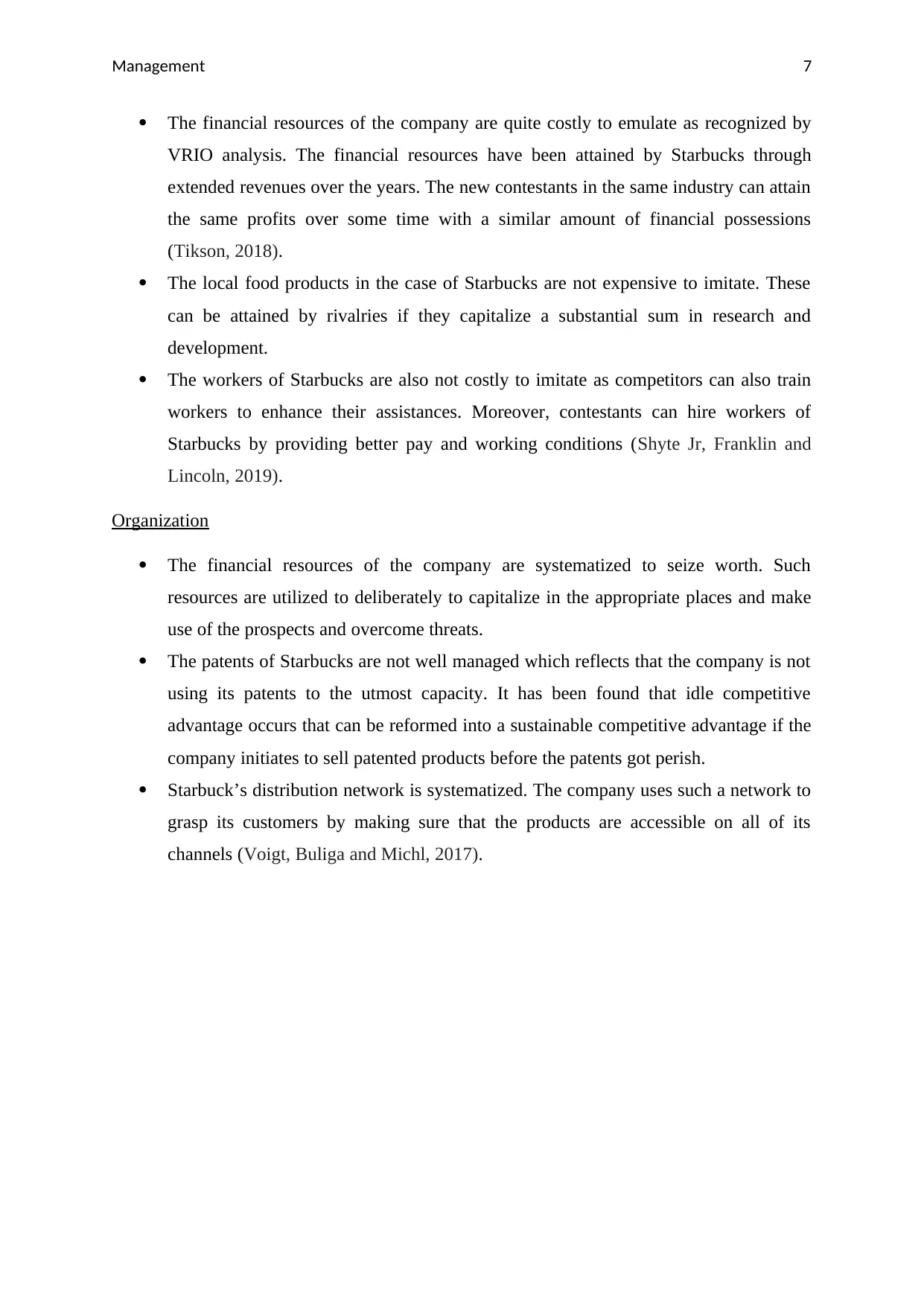
Management 7
The financial resources of the company are quite costly to emulate as recognized by
VRIO analysis. The financial resources have been attained by Starbucks through
extended revenues over the years. The new contestants in the same industry can attain
the same profits over some time with a similar amount of financial possessions
(Tikson, 2018).
The local food products in the case of Starbucks are not expensive to imitate. These
can be attained by rivalries if they capitalize a substantial sum in research and
development.
The workers of Starbucks are also not costly to imitate as competitors can also train
workers to enhance their assistances. Moreover, contestants can hire workers of
Starbucks by providing better pay and working conditions (Shyte Jr, Franklin and
Lincoln, 2019).
Organization
The financial resources of the company are systematized to seize worth. Such
resources are utilized to deliberately to capitalize in the appropriate places and make
use of the prospects and overcome threats.
The patents of Starbucks are not well managed which reflects that the company is not
using its patents to the utmost capacity. It has been found that idle competitive
advantage occurs that can be reformed into a sustainable competitive advantage if the
company initiates to sell patented products before the patents got perish.
Starbuck’s distribution network is systematized. The company uses such a network to
grasp its customers by making sure that the products are accessible on all of its
channels (Voigt, Buliga and Michl, 2017).
The financial resources of the company are quite costly to emulate as recognized by
VRIO analysis. The financial resources have been attained by Starbucks through
extended revenues over the years. The new contestants in the same industry can attain
the same profits over some time with a similar amount of financial possessions
(Tikson, 2018).
The local food products in the case of Starbucks are not expensive to imitate. These
can be attained by rivalries if they capitalize a substantial sum in research and
development.
The workers of Starbucks are also not costly to imitate as competitors can also train
workers to enhance their assistances. Moreover, contestants can hire workers of
Starbucks by providing better pay and working conditions (Shyte Jr, Franklin and
Lincoln, 2019).
Organization
The financial resources of the company are systematized to seize worth. Such
resources are utilized to deliberately to capitalize in the appropriate places and make
use of the prospects and overcome threats.
The patents of Starbucks are not well managed which reflects that the company is not
using its patents to the utmost capacity. It has been found that idle competitive
advantage occurs that can be reformed into a sustainable competitive advantage if the
company initiates to sell patented products before the patents got perish.
Starbuck’s distribution network is systematized. The company uses such a network to
grasp its customers by making sure that the products are accessible on all of its
channels (Voigt, Buliga and Michl, 2017).
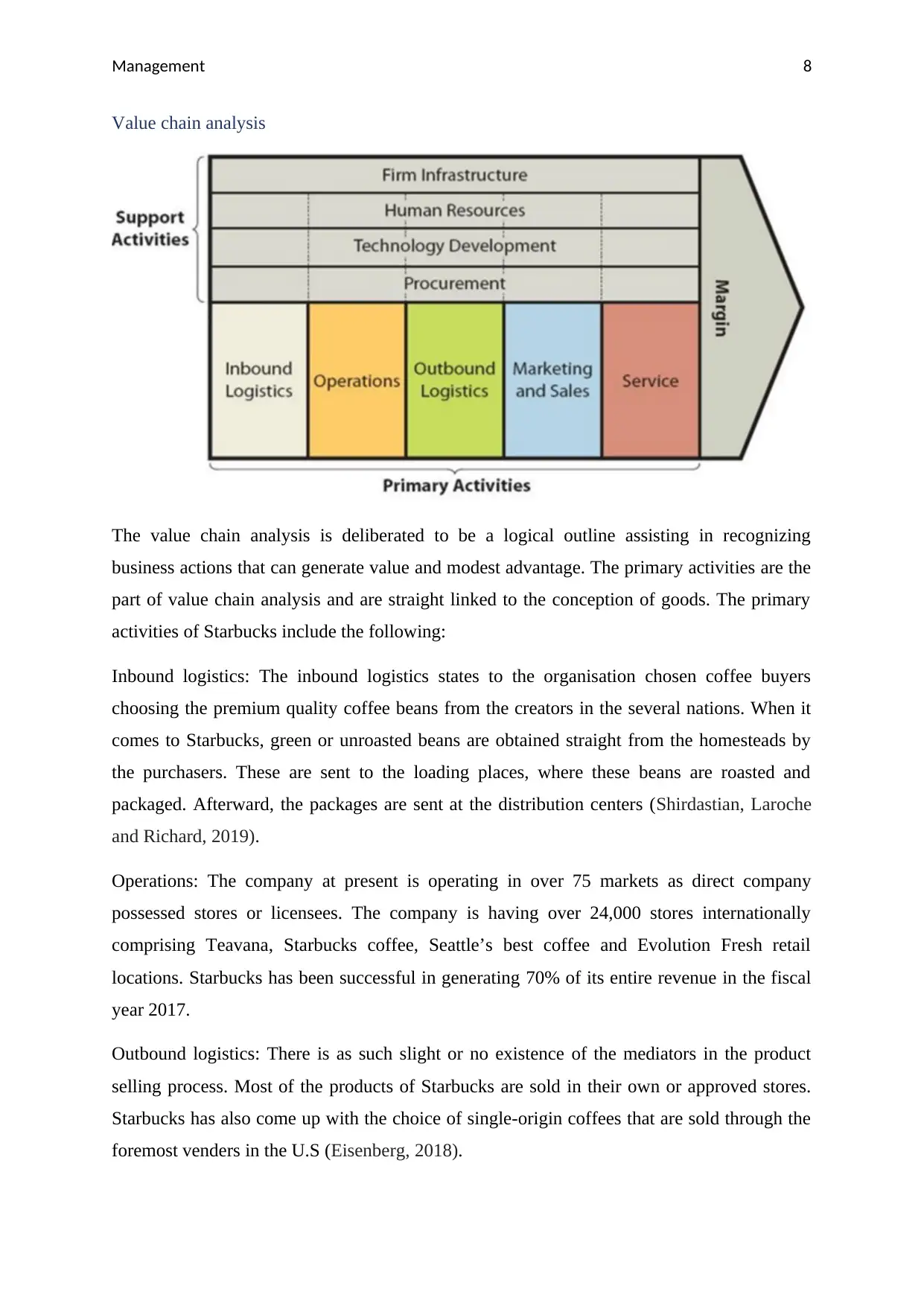
Management 8
Value chain analysis
The value chain analysis is deliberated to be a logical outline assisting in recognizing
business actions that can generate value and modest advantage. The primary activities are the
part of value chain analysis and are straight linked to the conception of goods. The primary
activities of Starbucks include the following:
Inbound logistics: The inbound logistics states to the organisation chosen coffee buyers
choosing the premium quality coffee beans from the creators in the several nations. When it
comes to Starbucks, green or unroasted beans are obtained straight from the homesteads by
the purchasers. These are sent to the loading places, where these beans are roasted and
packaged. Afterward, the packages are sent at the distribution centers (Shirdastian, Laroche
and Richard, 2019).
Operations: The company at present is operating in over 75 markets as direct company
possessed stores or licensees. The company is having over 24,000 stores internationally
comprising Teavana, Starbucks coffee, Seattle’s best coffee and Evolution Fresh retail
locations. Starbucks has been successful in generating 70% of its entire revenue in the fiscal
year 2017.
Outbound logistics: There is as such slight or no existence of the mediators in the product
selling process. Most of the products of Starbucks are sold in their own or approved stores.
Starbucks has also come up with the choice of single-origin coffees that are sold through the
foremost venders in the U.S (Eisenberg, 2018).
Value chain analysis
The value chain analysis is deliberated to be a logical outline assisting in recognizing
business actions that can generate value and modest advantage. The primary activities are the
part of value chain analysis and are straight linked to the conception of goods. The primary
activities of Starbucks include the following:
Inbound logistics: The inbound logistics states to the organisation chosen coffee buyers
choosing the premium quality coffee beans from the creators in the several nations. When it
comes to Starbucks, green or unroasted beans are obtained straight from the homesteads by
the purchasers. These are sent to the loading places, where these beans are roasted and
packaged. Afterward, the packages are sent at the distribution centers (Shirdastian, Laroche
and Richard, 2019).
Operations: The company at present is operating in over 75 markets as direct company
possessed stores or licensees. The company is having over 24,000 stores internationally
comprising Teavana, Starbucks coffee, Seattle’s best coffee and Evolution Fresh retail
locations. Starbucks has been successful in generating 70% of its entire revenue in the fiscal
year 2017.
Outbound logistics: There is as such slight or no existence of the mediators in the product
selling process. Most of the products of Starbucks are sold in their own or approved stores.
Starbucks has also come up with the choice of single-origin coffees that are sold through the
foremost venders in the U.S (Eisenberg, 2018).
⊘ This is a preview!⊘
Do you want full access?
Subscribe today to unlock all pages.

Trusted by 1+ million students worldwide
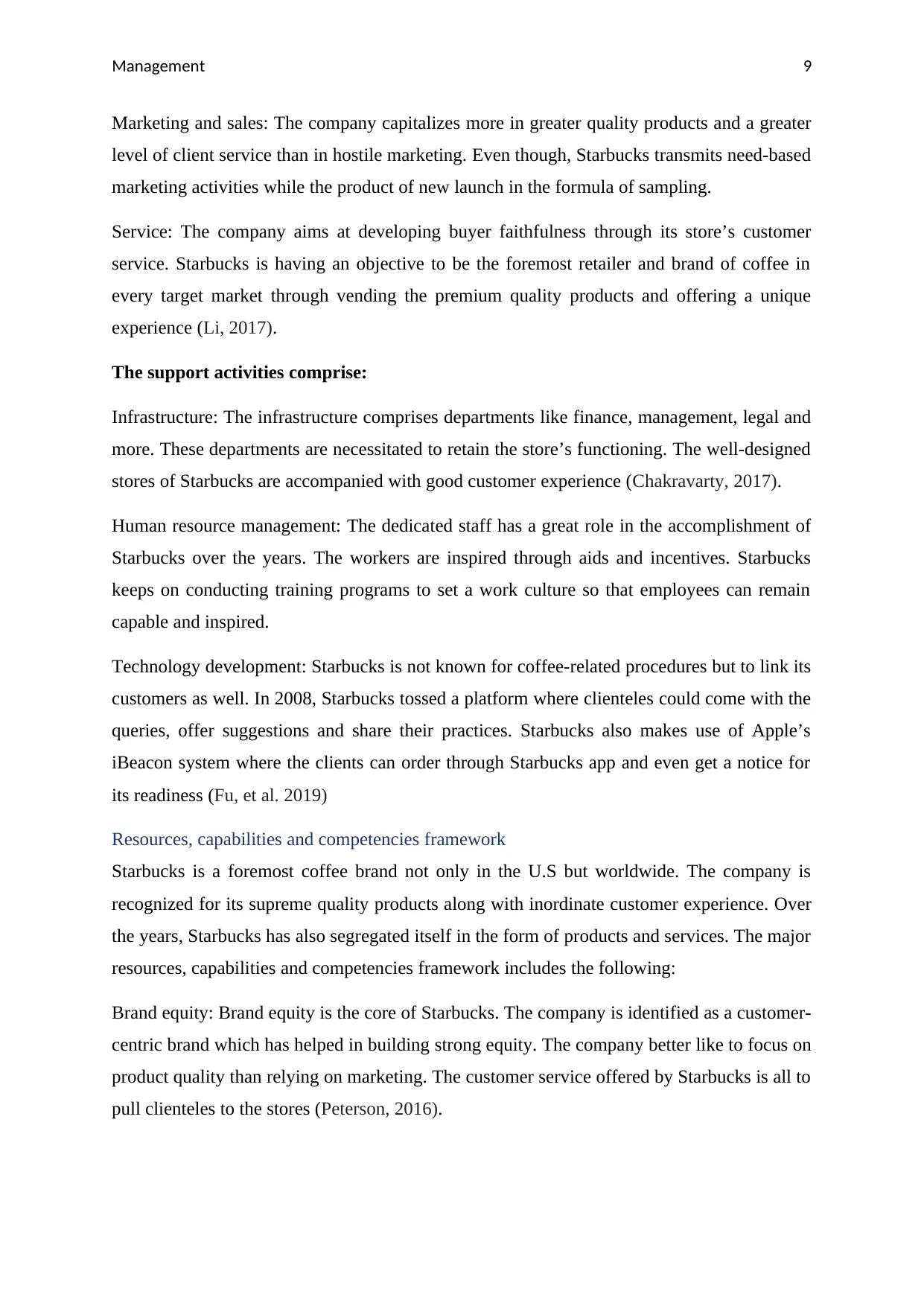
Management 9
Marketing and sales: The company capitalizes more in greater quality products and a greater
level of client service than in hostile marketing. Even though, Starbucks transmits need-based
marketing activities while the product of new launch in the formula of sampling.
Service: The company aims at developing buyer faithfulness through its store’s customer
service. Starbucks is having an objective to be the foremost retailer and brand of coffee in
every target market through vending the premium quality products and offering a unique
experience (Li, 2017).
The support activities comprise:
Infrastructure: The infrastructure comprises departments like finance, management, legal and
more. These departments are necessitated to retain the store’s functioning. The well-designed
stores of Starbucks are accompanied with good customer experience (Chakravarty, 2017).
Human resource management: The dedicated staff has a great role in the accomplishment of
Starbucks over the years. The workers are inspired through aids and incentives. Starbucks
keeps on conducting training programs to set a work culture so that employees can remain
capable and inspired.
Technology development: Starbucks is not known for coffee-related procedures but to link its
customers as well. In 2008, Starbucks tossed a platform where clienteles could come with the
queries, offer suggestions and share their practices. Starbucks also makes use of Apple’s
iBeacon system where the clients can order through Starbucks app and even get a notice for
its readiness (Fu, et al. 2019)
Resources, capabilities and competencies framework
Starbucks is a foremost coffee brand not only in the U.S but worldwide. The company is
recognized for its supreme quality products along with inordinate customer experience. Over
the years, Starbucks has also segregated itself in the form of products and services. The major
resources, capabilities and competencies framework includes the following:
Brand equity: Brand equity is the core of Starbucks. The company is identified as a customer-
centric brand which has helped in building strong equity. The company better like to focus on
product quality than relying on marketing. The customer service offered by Starbucks is all to
pull clienteles to the stores (Peterson, 2016).
Marketing and sales: The company capitalizes more in greater quality products and a greater
level of client service than in hostile marketing. Even though, Starbucks transmits need-based
marketing activities while the product of new launch in the formula of sampling.
Service: The company aims at developing buyer faithfulness through its store’s customer
service. Starbucks is having an objective to be the foremost retailer and brand of coffee in
every target market through vending the premium quality products and offering a unique
experience (Li, 2017).
The support activities comprise:
Infrastructure: The infrastructure comprises departments like finance, management, legal and
more. These departments are necessitated to retain the store’s functioning. The well-designed
stores of Starbucks are accompanied with good customer experience (Chakravarty, 2017).
Human resource management: The dedicated staff has a great role in the accomplishment of
Starbucks over the years. The workers are inspired through aids and incentives. Starbucks
keeps on conducting training programs to set a work culture so that employees can remain
capable and inspired.
Technology development: Starbucks is not known for coffee-related procedures but to link its
customers as well. In 2008, Starbucks tossed a platform where clienteles could come with the
queries, offer suggestions and share their practices. Starbucks also makes use of Apple’s
iBeacon system where the clients can order through Starbucks app and even get a notice for
its readiness (Fu, et al. 2019)
Resources, capabilities and competencies framework
Starbucks is a foremost coffee brand not only in the U.S but worldwide. The company is
recognized for its supreme quality products along with inordinate customer experience. Over
the years, Starbucks has also segregated itself in the form of products and services. The major
resources, capabilities and competencies framework includes the following:
Brand equity: Brand equity is the core of Starbucks. The company is identified as a customer-
centric brand which has helped in building strong equity. The company better like to focus on
product quality than relying on marketing. The customer service offered by Starbucks is all to
pull clienteles to the stores (Peterson, 2016).
Paraphrase This Document
Need a fresh take? Get an instant paraphrase of this document with our AI Paraphraser
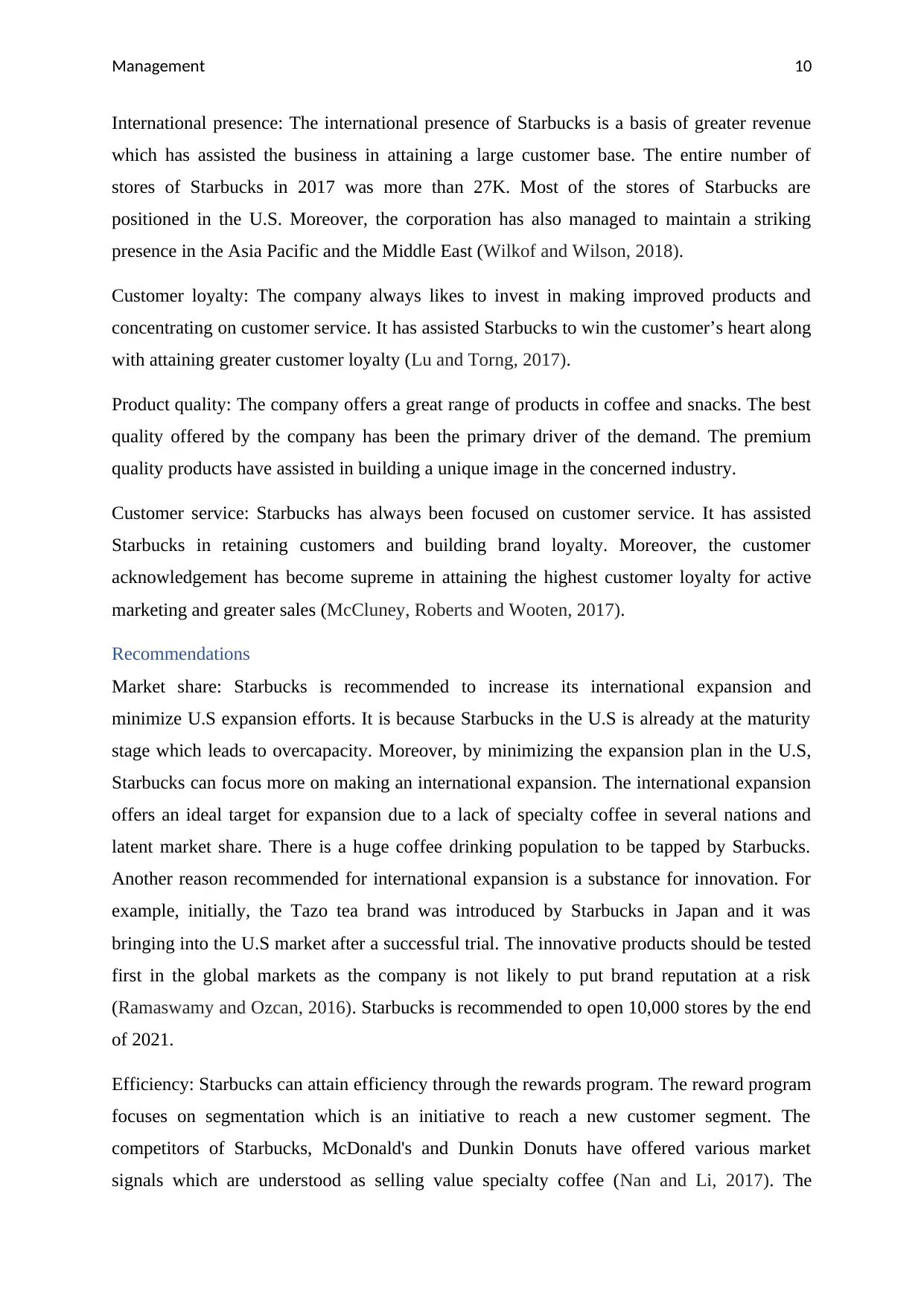
Management 10
International presence: The international presence of Starbucks is a basis of greater revenue
which has assisted the business in attaining a large customer base. The entire number of
stores of Starbucks in 2017 was more than 27K. Most of the stores of Starbucks are
positioned in the U.S. Moreover, the corporation has also managed to maintain a striking
presence in the Asia Pacific and the Middle East (Wilkof and Wilson, 2018).
Customer loyalty: The company always likes to invest in making improved products and
concentrating on customer service. It has assisted Starbucks to win the customer’s heart along
with attaining greater customer loyalty (Lu and Torng, 2017).
Product quality: The company offers a great range of products in coffee and snacks. The best
quality offered by the company has been the primary driver of the demand. The premium
quality products have assisted in building a unique image in the concerned industry.
Customer service: Starbucks has always been focused on customer service. It has assisted
Starbucks in retaining customers and building brand loyalty. Moreover, the customer
acknowledgement has become supreme in attaining the highest customer loyalty for active
marketing and greater sales (McCluney, Roberts and Wooten, 2017).
Recommendations
Market share: Starbucks is recommended to increase its international expansion and
minimize U.S expansion efforts. It is because Starbucks in the U.S is already at the maturity
stage which leads to overcapacity. Moreover, by minimizing the expansion plan in the U.S,
Starbucks can focus more on making an international expansion. The international expansion
offers an ideal target for expansion due to a lack of specialty coffee in several nations and
latent market share. There is a huge coffee drinking population to be tapped by Starbucks.
Another reason recommended for international expansion is a substance for innovation. For
example, initially, the Tazo tea brand was introduced by Starbucks in Japan and it was
bringing into the U.S market after a successful trial. The innovative products should be tested
first in the global markets as the company is not likely to put brand reputation at a risk
(Ramaswamy and Ozcan, 2016). Starbucks is recommended to open 10,000 stores by the end
of 2021.
Efficiency: Starbucks can attain efficiency through the rewards program. The reward program
focuses on segmentation which is an initiative to reach a new customer segment. The
competitors of Starbucks, McDonald's and Dunkin Donuts have offered various market
signals which are understood as selling value specialty coffee (Nan and Li, 2017). The
International presence: The international presence of Starbucks is a basis of greater revenue
which has assisted the business in attaining a large customer base. The entire number of
stores of Starbucks in 2017 was more than 27K. Most of the stores of Starbucks are
positioned in the U.S. Moreover, the corporation has also managed to maintain a striking
presence in the Asia Pacific and the Middle East (Wilkof and Wilson, 2018).
Customer loyalty: The company always likes to invest in making improved products and
concentrating on customer service. It has assisted Starbucks to win the customer’s heart along
with attaining greater customer loyalty (Lu and Torng, 2017).
Product quality: The company offers a great range of products in coffee and snacks. The best
quality offered by the company has been the primary driver of the demand. The premium
quality products have assisted in building a unique image in the concerned industry.
Customer service: Starbucks has always been focused on customer service. It has assisted
Starbucks in retaining customers and building brand loyalty. Moreover, the customer
acknowledgement has become supreme in attaining the highest customer loyalty for active
marketing and greater sales (McCluney, Roberts and Wooten, 2017).
Recommendations
Market share: Starbucks is recommended to increase its international expansion and
minimize U.S expansion efforts. It is because Starbucks in the U.S is already at the maturity
stage which leads to overcapacity. Moreover, by minimizing the expansion plan in the U.S,
Starbucks can focus more on making an international expansion. The international expansion
offers an ideal target for expansion due to a lack of specialty coffee in several nations and
latent market share. There is a huge coffee drinking population to be tapped by Starbucks.
Another reason recommended for international expansion is a substance for innovation. For
example, initially, the Tazo tea brand was introduced by Starbucks in Japan and it was
bringing into the U.S market after a successful trial. The innovative products should be tested
first in the global markets as the company is not likely to put brand reputation at a risk
(Ramaswamy and Ozcan, 2016). Starbucks is recommended to open 10,000 stores by the end
of 2021.
Efficiency: Starbucks can attain efficiency through the rewards program. The reward program
focuses on segmentation which is an initiative to reach a new customer segment. The
competitors of Starbucks, McDonald's and Dunkin Donuts have offered various market
signals which are understood as selling value specialty coffee (Nan and Li, 2017). The
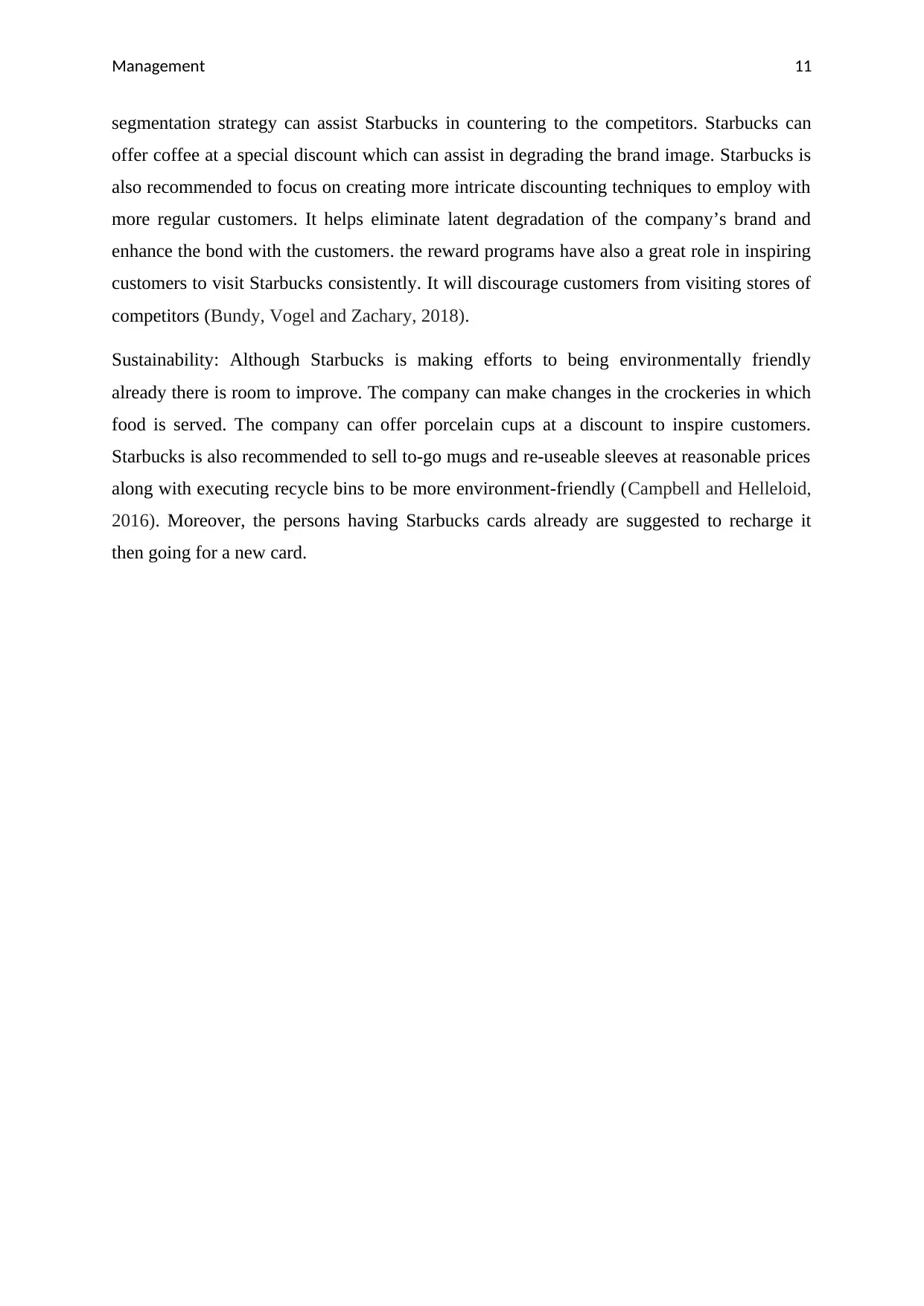
Management 11
segmentation strategy can assist Starbucks in countering to the competitors. Starbucks can
offer coffee at a special discount which can assist in degrading the brand image. Starbucks is
also recommended to focus on creating more intricate discounting techniques to employ with
more regular customers. It helps eliminate latent degradation of the company’s brand and
enhance the bond with the customers. the reward programs have also a great role in inspiring
customers to visit Starbucks consistently. It will discourage customers from visiting stores of
competitors (Bundy, Vogel and Zachary, 2018).
Sustainability: Although Starbucks is making efforts to being environmentally friendly
already there is room to improve. The company can make changes in the crockeries in which
food is served. The company can offer porcelain cups at a discount to inspire customers.
Starbucks is also recommended to sell to-go mugs and re-useable sleeves at reasonable prices
along with executing recycle bins to be more environment-friendly (Campbell and Helleloid,
2016). Moreover, the persons having Starbucks cards already are suggested to recharge it
then going for a new card.
segmentation strategy can assist Starbucks in countering to the competitors. Starbucks can
offer coffee at a special discount which can assist in degrading the brand image. Starbucks is
also recommended to focus on creating more intricate discounting techniques to employ with
more regular customers. It helps eliminate latent degradation of the company’s brand and
enhance the bond with the customers. the reward programs have also a great role in inspiring
customers to visit Starbucks consistently. It will discourage customers from visiting stores of
competitors (Bundy, Vogel and Zachary, 2018).
Sustainability: Although Starbucks is making efforts to being environmentally friendly
already there is room to improve. The company can make changes in the crockeries in which
food is served. The company can offer porcelain cups at a discount to inspire customers.
Starbucks is also recommended to sell to-go mugs and re-useable sleeves at reasonable prices
along with executing recycle bins to be more environment-friendly (Campbell and Helleloid,
2016). Moreover, the persons having Starbucks cards already are suggested to recharge it
then going for a new card.
⊘ This is a preview!⊘
Do you want full access?
Subscribe today to unlock all pages.

Trusted by 1+ million students worldwide
1 out of 18
Related Documents
Your All-in-One AI-Powered Toolkit for Academic Success.
+13062052269
info@desklib.com
Available 24*7 on WhatsApp / Email
![[object Object]](/_next/static/media/star-bottom.7253800d.svg)
Unlock your academic potential
Copyright © 2020–2025 A2Z Services. All Rights Reserved. Developed and managed by ZUCOL.




